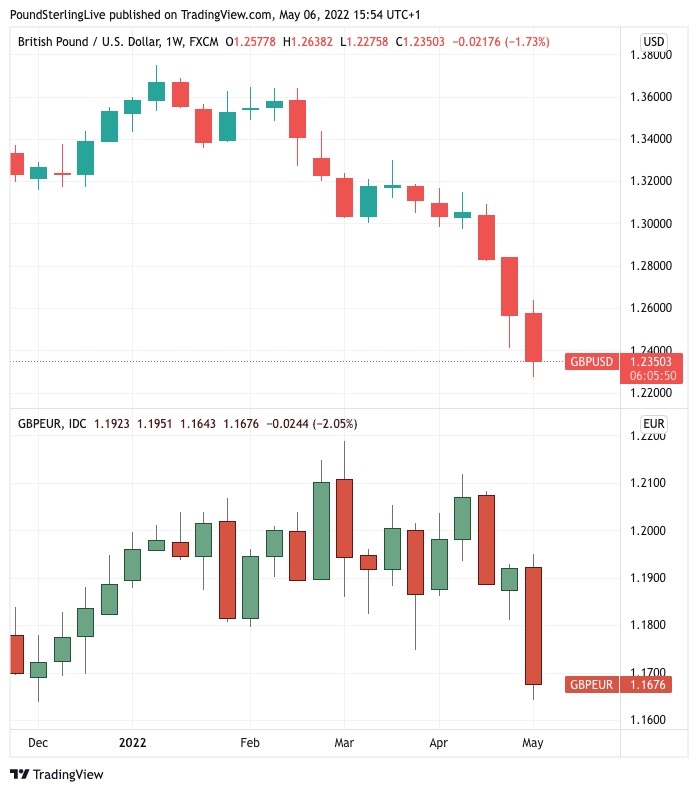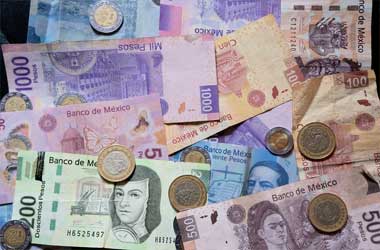 The pound lost considerable ground against the euro, the US dollar, and other top currencies in the week that ended and analysts stated that additional losses are likely in the week ahead even though a short-term rebound cannot be brushed away completely. The pound exchange rates declined steeply against the backdrop of the Bank of England’s decision to lift interest rates by 25 basis points but cautioned that economic growth could likely remain weak and inflationary pressure could increase further than anticipated earlier.
The pound lost considerable ground against the euro, the US dollar, and other top currencies in the week that ended and analysts stated that additional losses are likely in the week ahead even though a short-term rebound cannot be brushed away completely. The pound exchange rates declined steeply against the backdrop of the Bank of England’s decision to lift interest rates by 25 basis points but cautioned that economic growth could likely remain weak and inflationary pressure could increase further than anticipated earlier.
The reported details were the latest series of forecasts by the central bank. While the financial market was anticipating multiple steep hikes, there was no hint about that in the latest policy statement. This resulted in a reassessment on the lower side by the market and the pound was pushed below.
Chris Iggo, CIO of Core Investments, at AXA Investment Managers, said “The Bank of England, while announcing its fourth successive rate hike, cautioned about higher inflationary pressure and slowdown in growth. That sparked a negative response from the market in both equity and global bond markets. No one prefers stagflation.”
The GBP/EUR exchange rate plunged 1.44% Thursday. So far in May, the currency pair has lost about 2%. The GBP/USD exchange rate is staring at a steep loss of 4.30% for May. JP Morgan’s Forex dealing desk has written to customers stating that the pound’s weakness story has become so impact on the market at this moment that it is difficult to think about the recovery of the sterling.
From a strategic view, the desk calls for a long position on EUR/GBP pair, implying further likely losses in the UK’s legal tender. Analysts have called for 0.8560 and 0.86 as the next major levels (GBP/EUR at 1.1682 and 1.1630). Additionally, currency analysts at ABN AMRO, in the meantime, state that they also forecast additional pound weakness against the Euro and the Dollar.
Senior FX Strategist Georgette Boele opined that “the latest forecasts and the vague outlook of exchange rates continue to remain in disparity with market forecasts for additional considerable policy tightening, and the result of the meeting was precisely dovish than anticipated by the market.”
Economists at ABN AMRO anticipate two more rate hikes from the bank this year, representing a considerable blow to the expectations of market participants. These interest rate hikes are anticipated to happen in June and August but thereafter it is anticipated by the Bank of England to tilt in support of the doves, as the threat of recession starts to impact more seriously in policy considerations.
Boele said that the latest forecast is considerably dovish than what financial markets have assessed. Therefore, we still anticipate additional sterling weakness. ABM AMRO predicts that the EUR/GBP exchange rate to stay at 0.85 by the end of June, at 0.85 by the end of September, and at 0.86 by the end of December. This offers a GBP/EUR outlook in the range of 1.1765 and 1.1630.

With respect to the GBP/USD currency pair, forecasts by ABN AMRO stand at 1.26 by the end of June, 1.24 by the end of September, and 1.22 by the end of this year. Notably, the short-term momentum is against the pound, even though there could be intra-day rebounds in the coming week.
As of date, the consensus among currency analysts is that any robustness will probably remain only for the short term. An ongoing rebound could nevertheless happen after the market’s expectations for steep rate hikes fades away. In fact, the anticipated steep rate hikes had been highlighted by several analysts as a knife hanging above the pound’s head.
The recent data from other developed economies indicates that stagflation has become a common outlook, similar to the UK, and other currencies could come under pressure when the market starts realizing this. This would be aided by fading of expectations over steep rate hikes by central banks in other countries. However, this could take a little bit of time.




